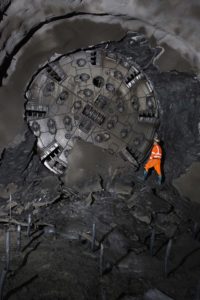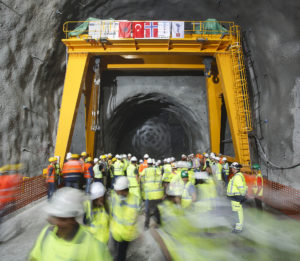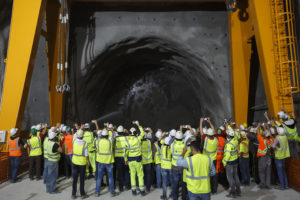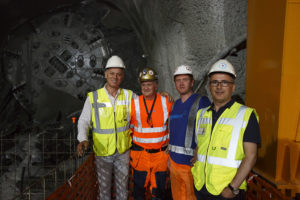Robbins XRE completes the First TBM-driven Tunnel in Albania
 On May 3, 2018 a 6.2 m (20.3 ft) diameter Robbins Crossover (XRE) TBM broke through into an underground chamber, marking the completion of the first TBM-driven tunnel in Albania. The TBM, operated by contractor Limak, was also the first Crossover machine to operate in Europe, and bored through geology including ophiolite, sandstone, breccia and siltstone flysch.
On May 3, 2018 a 6.2 m (20.3 ft) diameter Robbins Crossover (XRE) TBM broke through into an underground chamber, marking the completion of the first TBM-driven tunnel in Albania. The TBM, operated by contractor Limak, was also the first Crossover machine to operate in Europe, and bored through geology including ophiolite, sandstone, breccia and siltstone flysch.
“The cutterhead and cutters have achieved outstanding performance,” said Engin Gur, TBM Manager for Limak. The TBM achieved rates as high as 648 m (2,126 ft) per month in April 2018, and as much as 37.4 m (122.7 ft) in one day. The Crossover TBM did not encounter high-pressure water and was thus used in hard rock Double Shield mode throughout tunneling.
 “The TBM performed very well, as did a Robbins-supplied adit conveyor that operated in a 180-degree continuous curve. It was impressive,” said Max Walker, Robbins Field Service Superintendent. Several field service personnel remained onsite throughout operation of the TBM to provide guidance and trouble-shooting.
“The TBM performed very well, as did a Robbins-supplied adit conveyor that operated in a 180-degree continuous curve. It was impressive,” said Max Walker, Robbins Field Service Superintendent. Several field service personnel remained onsite throughout operation of the TBM to provide guidance and trouble-shooting.
The machine was launched in November 2016 following Onsite First Time Assembly (OFTA), which enabled the machine to be initially assembled at the jobsite. The crew ramped up production slowly over the next 230 m (755 ft). “Ground conditions were good and we did very few cutter changes—only 20 cutters were used during the bore,” said Walker. Two-stage grouting was carried out as the TBM bored and lined the tunnel in three 8-hour shifts. “The personnel on this project have created a friendly work environment; they’ve made it enjoyable coming to work each day. They’re good guys to work with,” he added.
 While the TBM did not need to be sealed, the unique machine design took into account a predicted high risk of water inflows. The Crossover XRE machine used a belt conveyor and not a screw conveyor for muck removal, so the muck chute needed to be able to be sealed off in the case of an inrush of water. The bulkhead was thus designed with a large sealing gate just above the belt conveyor. These pressure-relieving gates could also be used in a semi-EPB mode: As the pressure built in the cutting chamber, the gate would then be opened by the pressure, and material would spill onto the belt. As the pressure lowered, the gates would then automatically close, again sealing off the chamber. In extreme cases, the gates could be sealed and the probe/grout drills could be used to drill, grout, and seal off water. Additionally, the gripper shoes and inner telescopic shield were designed with inflatable seals to further protect against inrushes of water.
While the TBM did not need to be sealed, the unique machine design took into account a predicted high risk of water inflows. The Crossover XRE machine used a belt conveyor and not a screw conveyor for muck removal, so the muck chute needed to be able to be sealed off in the case of an inrush of water. The bulkhead was thus designed with a large sealing gate just above the belt conveyor. These pressure-relieving gates could also be used in a semi-EPB mode: As the pressure built in the cutting chamber, the gate would then be opened by the pressure, and material would spill onto the belt. As the pressure lowered, the gates would then automatically close, again sealing off the chamber. In extreme cases, the gates could be sealed and the probe/grout drills could be used to drill, grout, and seal off water. Additionally, the gripper shoes and inner telescopic shield were designed with inflatable seals to further protect against inrushes of water.
With the breakthrough now complete, grouting will continue behind the TBM segments. No additional lining will be added, and the tunnel is expected to become operational by May 2019.
 The 6.7 km (4.2 mi) long Moglicë headrace tunnel is part of the Devoll Hydropower Project, a Build-Own-Operate-Transfer (BOOT) scheme to construct two hydropower plants along the Devoll River, named Moglicë and Banja. The project is owned by the Norwegian power company Statkraft AS. The completed Devoll Hydropower Project will increase Albania’s electricity production by 17% and will have an installed capacity of 242 MW.
The 6.7 km (4.2 mi) long Moglicë headrace tunnel is part of the Devoll Hydropower Project, a Build-Own-Operate-Transfer (BOOT) scheme to construct two hydropower plants along the Devoll River, named Moglicë and Banja. The project is owned by the Norwegian power company Statkraft AS. The completed Devoll Hydropower Project will increase Albania’s electricity production by 17% and will have an installed capacity of 242 MW.
